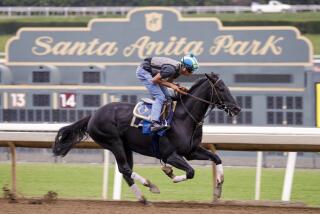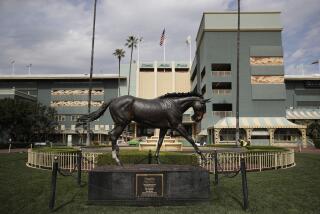Major horse racing tracks agree to phase out use of race-day Lasix

In an unprecedented step of cooperation, the three major groups that control horse racing and most of the major independent tracks announced an initiative that would eliminate the use of race-day Lasix for 2-year-olds and a year later extend to all horses in stakes races, including the three Triple Crown races.
The Stronach Group, Churchill Downs Inc. and New York Racing Assn. Inc, which are normally at odds with one another over revenue from their advance deposit wagering companies, came together along with other tracks including Del Mar and Los Alamitos thoroughbreds to toughen Lasix standards. But the rules are still short of what the Stronach Group has implemented at Santa Anita, Golden Gate Fields and, in the future, its tracks in Florida and Maryland.
Under the agreement, 2-year-olds will be prohibited from being treated with Furosemide (Lasix) within 24 hours of racing. In 2021, the ban will extend to all stakes races at any of the participating tracks regardless of the horse’s age. It means in two years, that the Triple Crown races, at Churchill Downs, Pimlico and Belmont Park, will not allow race-day Lasix for the 3-year-olds.
However, once those 2-year-olds become 3-year-olds, they will be allowed to run with Lasix in nonstakes races.
Lasix is primarily used to treat exercise-induced pulmonary hemorrhage, which occurs when horses bleed from the lungs when running. More than 95% of all horses in the United States run with Lasix on race day. Santa Anita’s current rules have lowered race-day Lasix from 10cc to 5cc. Next year, it will be prohibited for 2-year-olds and that rule will carry forward as the horses get older.
“I believe it’s the first time in more than 20 years, maybe since the foundation and formation of the National Thoroughbred Racing Assn., that owners, breeders, trainers and race tracks from across the country have joined together to move forward,” said Rick Baedeker, executive director of the California Horse Racing Board. “Everybody probably categorizes this as an important first step in continuing to work together.”
The industry has been under attack from animal rights’ groups after the death of 23 horses at Santa Anita since Dec. 26.
At Thursday’s meeting of the racing board at Santa Anita, a 90-minute public comment period was dominated by animal rights’ advocates calling for the closure of Santa Anita. Board members, especially Madeline Auerbach, vice chairman, bristled when animal-rights advocates brought up the idea that racehorses were sent to slaughter after their careers were over.
Auerbach challenged the first few speakers saying “it’s just not true” and pointing out that California has regulations against the slaughter of horses. Auerbach, a longtime owner, is a leading voice in the aftercare of racehorses.
A meeting was originally scheduled for last Friday to discuss the moving of dates at Santa Anita in light of the horse deaths. However, it was cancelled and an agenda item was included in Thursday’s meeting. The idea of Santa Anita giving up its dates was dispensed with in 1 minute 15 seconds without discussion.
“My view is that racing since Santa Anita has reopened, it has been really good,” Chuck Winner, chairman, said. “There have been no accidents. Personally, I see no reason to move the race dates.”
Actually, Santa Anita did have a death on March 31 when Arms Runner broke his leg on the downhill turf course, which has since been closed since for sprints. Since that death, 502 horses have started without a fatality. There have been 4,195 horses with timed workouts during training since March 14 without a death.
Of the 23 deaths, 10 have come in training, seven on the main dirt course during racing and six during turf racing.
At the racing board meeting, Baedeker said that the board has four full-time investigators looking at the deaths at Santa Anita. He said all but one of the necropsies have been completed and that more than 70 subpoenas for documents have been issued. He said the racing board is working with the L.A. district attorney’s office in its investigation.
Sign up for our horse racing newsletter »
“Cooperation has been very good from all responding parties,” Baedeker said. “As you can guess this is very detailed, very thorough, very complicated process. Investigations take time but I can assure the board, and all interested parties, that it remains the highest priority of the CHRB.”
The initiative announced Thursday is less stringent than what was announced and approved by Belinda Stronach, president and chief executive of the Stronach Group, in an open letter to fans a couple of weeks ago. Her proposals include greater medication restrictions including the eventual phasing out of race-day Lasix in all races, not just stakes.
Asked if she was disappointed that the initiative was not stronger, Stronach defended the collective action.
“Quite the opposite, I’m encouraged by this industry-led movement to address serious issues within our sport,” Stronach told the Los Angeles Times. “This is a landmark reform that will go a long way towards further protecting the horses that are the lifeblood of our sport. As a strong advocate for the more aggressive medication-based reforms enacted just [Thursday] by the California Horse Racing Board, we will continue to work with our industry partners, elected leaders, regulators and anyone else on additional measures that will add safeguards around racing and training.”
Other national tracks that have joined the coalition include Keeneland (Ky.), Lone Star Park (Texas), Remington Park (Okla.), Oaklawn Park (Ark.) and Tampa Bay Downs (Fla.). The tracks are said to represent 86% of all the stakes races.
More to Read
Get our high school sports newsletter
Prep Rally is devoted to the SoCal high school sports experience, bringing you scores, stories and a behind-the-scenes look at what makes prep sports so popular.
You may occasionally receive promotional content from the Los Angeles Times.







